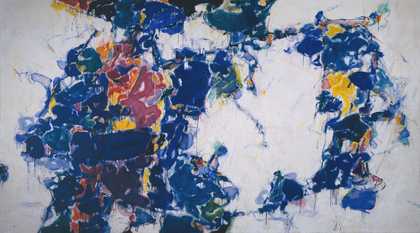
Fig.1
Sam Francis
Around the Blues 1957, 1962–3
Oil paint and acrylic paint on canvas
2755 x 4875 x 50 mm
Tate T00634
© Sam Francis Foundation, California/ARS, NY and DACS, London 2019
In 1957, at the time he started painting Around the Blues 1957, 1962–3 (Tate T00634; fig.1), Sam Francis had just begun his first of two trips around the globe. These episodes of international travel marked the closure of seven fruitful years in Paris from 1950 to 1957, where he had produced his first body of work that had attained critical acclaim, effectively funding his extensive global travel. These trips also coincided with a distinct shift in Francis’s work towards paintings featuring large expanses of white.1 Such white passages are clearly visible, for instance, in a large section at centre-right as well as at the left and right edges of Around the Blues, which was likely painted during a three-month stay in Mexico City in spring 1957.2 Francis recalled of this period: ‘At the end of the fifties, I was becoming dissatisfied with Paris. I started going to Japan, I went to America. I was dissatisfied with my painting, with my life, with everything.’3 Although he framed its impetus negatively, the 1957–60 travel period was in fact extraordinarily productive for Francis, who completed more than a hundred canvases – many of them large – in half a dozen different studios. More than an evasion, travel was for Francis a means by which to re-evaluate and consider, with increased concentration, the conditions under which a painting could be made, and how that painting might be understood once released into the world. In these years Francis leveraged literal disorientation to reorient his painting practice.
The circumstances of these paintings’ production were unusual, to say the least. Over four years Francis visited some two dozen cities, painting all the while and sometimes working on the same canvas across multiple sites. The itinerary is dizzying: in 1957 he visited, in roughly this order, Paris, New York, South Dakota, Mexico, California, New York, the Hamptons, Tokyo, Hong Kong, Bangkok, India and Rome. In 1958: Paris, Los Altos, New York, Paris, Basel, Paris, Provence, London, Paris, Rome, New York, Baltimore and Los Altos. The travel continued apace in 1959: Seattle, New York, Paris, Switzerland, Rome, Hong Kong, Tokyo, Washington, D.C. and New York; 1960 took him to London, Paris, Bern, Rome, Milan, Provence, England, Switzerland, Stockholm, Rome, New York, and Tokyo via Alaska.4 Travel, then, was not a parallel or fleeting concern, but a defining and keenly felt aspect of Francis’s experience. The titles of some of Francis’s paintings – Sioux Falls, Idaho 1957, Japan Line 1957, Untitled (Tokyo) 1957, Paris Summer 1958, Deux Magots c.1959–60 (all in private collections) – index specific locations the artist visited, while others – Around the Blues, Round the World 1958–60 (Fondation Beyeler, Riehen/Basel), Floating Blue 1958–9 (Mildred Lane Kemper Art Museum, Washington University, St Louis), Blue on a Point Towards Disappearance 1958 (Aichi Prefectural Museum of Art, Nagoya) – forego location but evoke space as it is experienced while in movement. Despite the near exact concurrence of Francis’s restless circumnavigations with his production of such canvases, the scholarship on Francis has not yet identified them as a coherent body of work with an appellation of its own. In referring to Francis’s 1957–9 works as his travel paintings, this essay is the first to do so.5
Commentators were quick to note that the travel paintings resembled landmasses viewed aerially, as if they were rainbow-toned, abstracted maps. For critic Dore Ashton, the artworks at the artist’s 1958 solo exhibition at the Martha Jackson Gallery in New York approximated ‘seas of white … inhabited by clustered islands and promontories’, like a ‘vista seen from a great height’.6 On a visit to Francis’s New York studio that same year, another reviewer likened the towering, bold-hued forms atop white grounds to ‘the continents of a map surrounded by ocean and broken up by inland lakes and bays’.7 But this tidy observation neglects to account for much else besides: why or how travel catalysed this shift in Francis’s painting, how we might read the canvases’ newfound predominance of white passages, or how the disorientation of air travel affected the artist’s practice. What might it mean to take seriously the psychological, physical and perceptual impact of travel on both Francis and his painting? This essay argues that Francis’s late-1950s travel paintings such as Around the Blues are results of, and ruminations on, the visual and spatial effects of air travel and the philosophical discourses on perception that constituted his intellectual formation prior to 1957.
Extension and depth
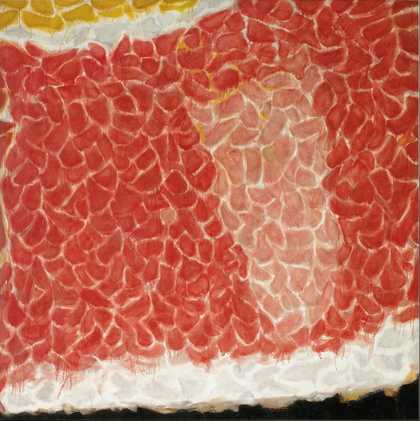
Fig.2
Sam Francis
Red in Red 1955
Anderson Collection, Stanford University, Stanford
© Sam Francis Foundation, California/ARS, NY and DACS, London 2019
When Francis first exhibited his white-infused paintings at the Martha Jackson Gallery in 1957 and 1958, and at London’s Gimpel Fils gallery in mid-1957, his reputation was already secure. Critics had aligned the American painter’s early to mid-1950s work with the French modern tradition, especially the work of Claude Monet (1840–1926) and Pierre Bonnard (1867–1947). Observing these earlier canvases’ all-over webs of shimmering, floating, amoeba-like forms, like those of Red in Red 1955 (fig.2), reviewers were primarily concerned with the movement and luminosity that seemed to emanate from them.8 French critics noted ‘shapes that seemed to move and shift in and out with a pulsating rhythm’, contributing to the sense of ‘an open sky that gives full freedom to variations of light and colour’.9 Faced with describing these early canvases’ internal space, however, reviewers had less to say, and with less conviction. Julien Alvard, an enthusiastic supporter, said only that the works made a strong ‘appeal for space’, while for Jacques Peuchmaurd the paintings placed the spectator rather ambiguously ‘on the edge of a new world’.10 For the most part, critics concurred that Francis’s early paintings offered some kind of resplendent arena beyond the picture plane, even if they were unclear about, or less interested in, its precise character.
The nature of pictorial space had always been a vital area of enquiry for painters. Yet the emergence of abstraction, and, more proximately to Francis’s time, of abstract expressionism in America, intensified its urgency by disavowing linear perspective and challenging the traditional notion of a painting as a window onto the world. Presented with canvases by abstract expressionists Jackson Pollock or Mark Rothko, for example, critics perceived a range of spatial depth, from total flatness to deep recession. Most responses were metaphorical in nature, likening these coloured abstract spaces to domestic mountainscapes, urban skylines, weather phenomena, or the intangible space of emotional or spiritual imagination. Rothko’s paintings, which had impressed Francis in late 1940s San Francisco, for example, could evoke both ‘glowing caverns’ and ‘atmospheric pressure’, according to artist and critic Elaine de Kooning.11 The wide range of attempts by critics to codify their reactions to abstract form and space even led de Kooning to comment that the content of Rothko’s ‘empty’ canvases was filled in by the multivalent projections of their viewers.12
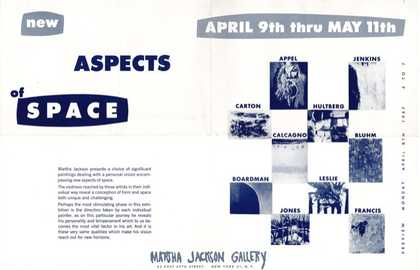
Fig.3
Exhibition announcement for New Aspects of Space, Martha Jackson Gallery, New York, 1957
Image courtesy of the Martha Jackson Archives, University at Buffalo Anderson Gallery, State University of New York at Buffalo
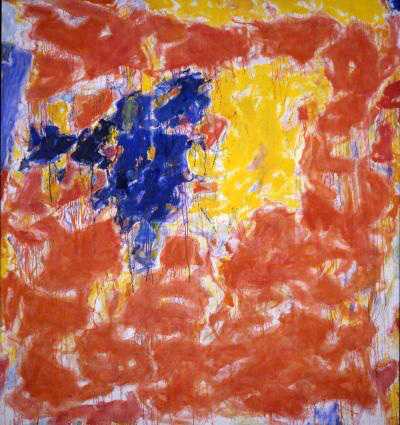
Fig.4
Sam Francis
Arcueil 1956, 1958
Oil on canvas
2051 x 1930 mm
Mildred Lane Kemper Art Museum, Washington University, Saint Louis
© Sam Francis Foundation, California/ARS, NY and DACS, London 2019
In 1957 and 1958 Francis participated in two exhibitions that purported to assess contemporary painters’ articulations of space. In the first of these, New Aspects of Space (9 April – 11 May 1957; fig.3), gallerist Martha Jackson translated the titular statement into an ambitious group show featuring Norman Bluhm, Seymour Boardman, Francis, John Hultberg and Paul Jenkins, among others. Reviewing the show in the New York Times, Dore Ashton noted that collectively the exhibited works tended towards a ‘limited illusion of depth … [and] a lateral extension of space … that thins out into infinity’, remarking that Francis’s work particularly exemplified this mode.13 She found Francis’s contribution to the show, Arcueil 1956, 1958 (fig.4), to elicit a sense of planar expansion, as if its washy yellow patches were ‘dilating beyond the top of the canvas’.14 Similarly, other writers avowed that the works seemed like details of larger wholes.15
In a second notable exhibition, Abstract Impressionism at London’s Arts Council Gallery (11–28 June 1958), curator Lawrence Alloway brought together paintings that evoked pictorial space not through the traditional painterly strategies of size or linear perspective, but through the suggestion of light and atmosphere. Although the term he employed for this emerging trend proved dead on arrival, ‘abstract impressionism’ as a conjunction of terms elucidated two chief concerns pertinent to the present context. First, the perception of light, air and space rather than attention to the materiality of paint on canvas; and second, the use of bluing and haze as a cue for distance, so that the ‘indiscriminability’ (to use Alloway’s term) that one usually expects of painted objects near a depicted horizon becomes coincident with the picture plane itself, as if spread or turned upward to extend across the whole canvas.16 Although both Jackson and Alloway claimed their shows uncovered innovative trends in the depiction of space, the works Francis exhibited in each connoted two manifestly distinct means of doing so: a sideward or vertical extension off and away from the canvas in the Martha Jackson exhibition, and an opening up of the picture plane in the Alloway show.
The distinction between these two modes of spatial depiction is significant because it continued to operate, with increased clarity, in critical reactions to Francis’s travel paintings. Note, too, that viewers immediately understood these works to be rooted in the observable world rather than as abstracted internal visions as had been the case for many abstract expressionist and art informel pictures. It was in this sense that critic Bennett Schiff could write that the blue, red, orange and purple forms in 1958 travel paintings like Blue on a Point Towards Disappearance and Moby Dick 1957–8 (Museum of Modern Art, New York) ‘seem to happen, to be there, the way nature is there’.17 The dominance of large swathes of modulated white in these 1957–9 travel paintings was a striking enough departure from the earlier work that most writers remarked on it, and grappled with how to describe and explain it. For her part, adding to the painting-as-map analogy quoted above, Ashton continued to insist that space in Francis’s paintings functioned as planar expansion; the fields of white read as ‘huge white voids’ that were ‘free to waft into unending openness’.18
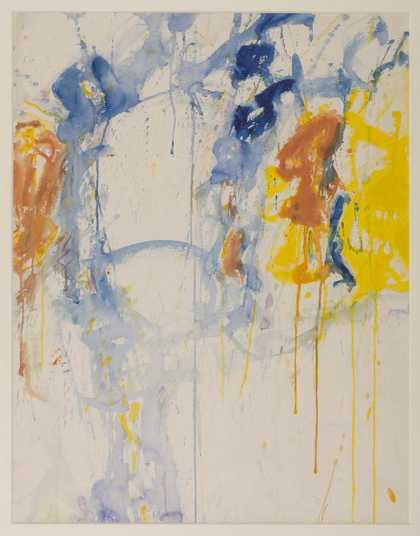
Fig.5
Sam Francis
Painting 1957
Tate T00148
© Sam Francis Foundation, California/ARS, NY and DACS, London 2019
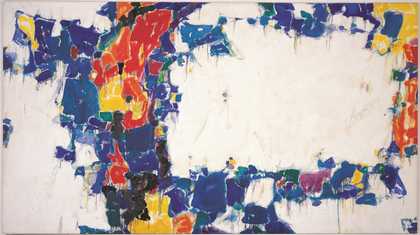
Fig.6
Sam Francis
Mexico 1957
Oil on canvas
2395 x 4275 mm
Ohara Museum of Art, Kurashiki
© Sam Francis Foundation, California/ARS, NY and DACS, London 2019
Reviewers of Francis’s spring 1957 solo show at Gimpel Fils deemed his travel works ‘penetrable’, akin to an open door or ‘a way that has been marked out, a stage that must be passed through’.19 Notably, the Gimpel Fils exhibition was among the first to showcase the canvases Francis had started making during his international expeditions. It presented a suite of watercolours on paper, including Painting 1957 (fig.5), and debuted the large-scale oil painting Mexico 1957 (fig.6), something of a companion piece to Around the Blues insofar as the two share a compositional structure, are similar in size, and were both painted in Mexico City. Back in New York, the travel paintings’ ‘fragile, tenuous forms … woven through large stretches of space’ occasioned buoyant visions of underwater seascapes; one writer likened the artist to ‘a Monet who dives through the water lilies to the depths’.20 The traces of spatial depth that critics had hinted at in the earlier Paris works had, by the late 1950s, become a fully available, even inviting, openness into which the viewer could imagine his or her presence.
Abstracting space in the jet age
Salient in all of this is that while Francis’s interpreters had done well to call out the two modes or vectors of space operating in his 1957–9 travel paintings – planar extension and pictorial depth – their responses were restricted by art historical tradition. The references that these writers called upon were those of Monet specifically or impressionism generally, of the rejection of illusionism, or of the empirical knowledge taken from the observations of a stable, vertically oriented spectator confronting a vertically hung canvas in a gallery. But what if the interpretative frame were to shift away from the vocabularies and experiences engendered by the tradition of modern painting towards those of flight?
Undeniably, Francis was a painter by training and had been schooled in art history.21 But he had spent just as much time in the sky. Alloway had intuited this when he wrote in his Abstract Impressionism catalogue essay of aerial perspective in Francis’s and others’ paintings as a cue for pictorial depth; critic Stuart Preston had come close, too, in detecting the ‘airiness of [Francis’s] feeling for space’ in Around the Blues and the watercolours accompanying it at the Martha Jackson Gallery in 1957.22 Indeed, Francis was explicit about the importance of flying for making his art. In his telling, it was as if suspension in upper air was almost a minimum condition for the production of paintings: ‘There is no conflict in my painting. The conflict is in my life. I feel trapped by gravity. I would like to fly, to soar, to float, but I am tied down to a place. No matter where I am, Tokyo, New York, Los Angeles, Bern, painting is a way out.’23 Painting was an antidote, a powerful attempt to defy gravity. Emerging from the pattern of responses to Francis’s travel paintings is a strong hypothesis that he brought the perceptual competencies gained in air travel to bear on his painting practice, and that the paintings themselves posed questions regarding the knowability of perception, space, time and distance.24
By the late 1950s, the accelerated pace of Cold War-fuelled space exploration had permeated the American cultural imagination. October 1957 marked the Soviet Union’s launch of Sputnik, the world’s first artificial satellite, while October 1958 saw the first jet services travelling from New York to Europe. Thus, the advent of the jet age coincided with the advent of the highly publicised space race, and both were accompanied by a rhetoric of bold innovation and nationalistic optimism. While some feared painting’s insufficiency in the face of such rapid scientific and technological advancements, others investigated art’s longstanding involvement with questions about the discovery of space that the jet age had renewed. Critic Charlotte Willard, writing for Art in America in 1958, blithely declared that ‘any school boy can tell you, space is not what it used to be’, given all the ‘satellites, jet planes, inter-continental missiles, [and] television frequencies … vibrating through our private air’.25 Yet, she wrote, outer space had been the province of artists for some time, at least since Leonardo di Vinci’s fifteenth-century flying machines. Going on to detail the intersections between individual artists’ aesthetics and the imagery of space exploration, Willard identified a formal similarity between Francis’s paintings and the granulated surface of the sun. She thus updated her colleagues’ tendency to see nature in Francis’s canvases, substituting their metaphors of earthbound surface-scapes with those of outer space.26
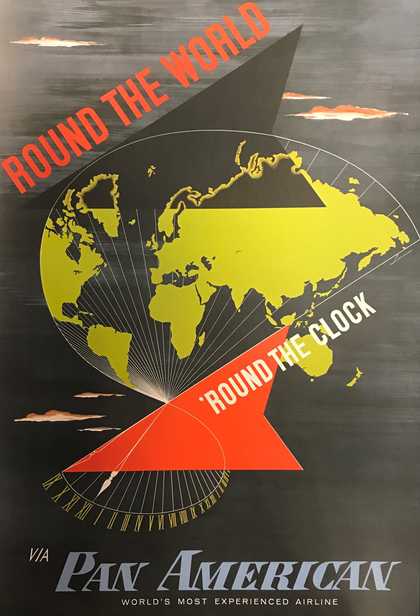
Fig.7
Loweree
Poster design for Pan American, 1955
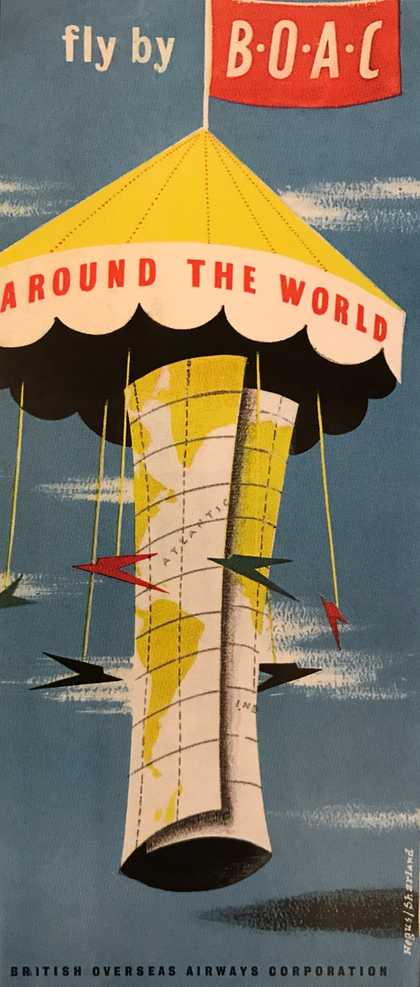
Fig.8
Dick Negus and Phillip Sharland
Poster design for the British Overseas Airway Corporation, c.1955
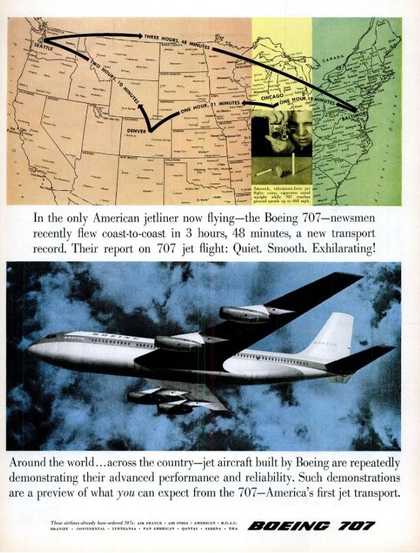
Fig.9
Full-page advertisement for the Boeing 707 published in Life, 9 September 1957, p.5
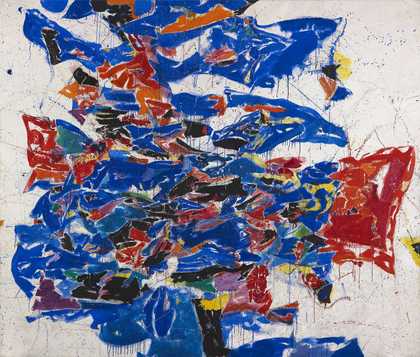
Fig.10
Sam Francis
Round the World 1958–9, 1960
Oil on canvas
2765 x 3215 mm
Fondation Beyeler, Basel
© Sam Francis Foundation, California/ARS, NY and DACS, London 2019/Laut ProLitteris
Photo © Peter Schibli
The jet travel in the late 1950s that made Francis’s global voyages feasible occasioned a deluge of superlative-studded advertisements espousing speedy, affordable, long-distance services as the major airlines vied for prominence. The first transatlantic jetliner service launched in 1958 and more than halved the duration of a comparable propeller flight, contributing to a drastic increase in the popularity of commercial air travel.27 Poster designs for the two leading carriers, Pan American (Pan Am) and the British Overseas Airway Corporation (BOAC), and an advertisement for the Boeing 707 aircraft (figs.7–9) attest that ‘(a)round the world’ was something of a promotional watchword at this time, one that any seasoned traveller was likely to recognise. Although Francis was often enigmatic in his titles from this period, the plainspoken rhetoric of his Round the World 1958–9, 1960 (fig.10) seems neither coincidental nor inconsequential in this context. The title suggests that travel had pervaded Francis’s conceptualisation of an artwork so deeply that it impacted both that artwork’s naming and its painterly articulation of space. Round the World, which Francis began only a year after Around the Blues, is an exemplary travel painting in that it traversed the globe with Francis: conceived in the garden of a Swiss collector, it was painted in Paris, New York and Bern. The kinship in the two paintings’ titles begs interpretation: is Round the World descriptive of scientific fact (‘round, the world’) or of locomotion (‘we flew round the world’)? Similarly, what might Around the Blues’s titular colour encircle, insofar as its blueness can be ascribed to the real world – might it refer to sky, water, eyes, thought? Or, following Francis (‘the blue of the atmosphere, seen from a jet plane, 30,000 feet in the air, it fascinates me’), might blue be a metaphor for the special quality of atmosphere, for space itself?28
Francis, through his years of global circumnavigation, would have been keenly aware of the sensations of depth and distance elicited by hours upon hours of gazing out of an aeroplane window, and, in paintings like Around the Blues, Mexico and Round the World, he transposed the experience of these sensations into a pictorial context. Notably, the two modes of spatial address recited on his work in the critical press – planar expansion and pictorial depth – find a corollary in the two types of vision possible from inside an aircraft: downwards, at the earth passing below, and outwards, towards the horizon.
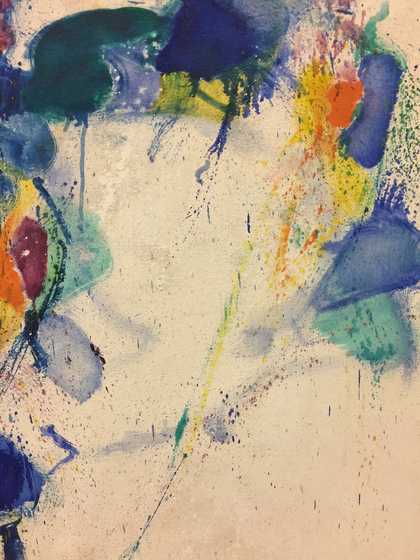
Fig.11
Sam Francis
Around the Blues, detail
© Sam Francis Foundation, California/ARS, NY and DACS, London 2019
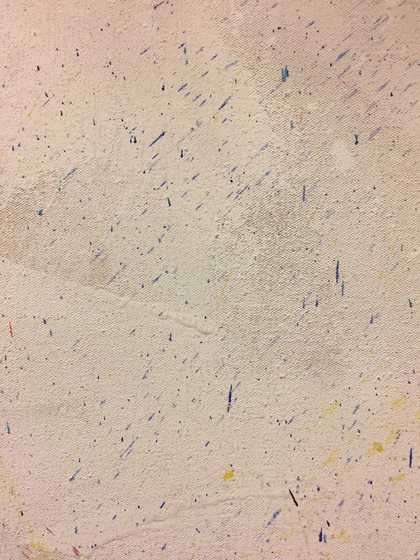
Fig.12
Sam Francis
Around the Blues, detail
© Sam Francis Foundation, California/ARS, NY and DACS, London 2019
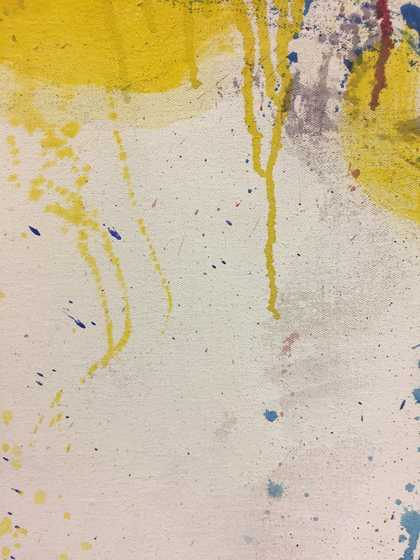
Fig.13
Sam Francis
Around the Blues, detail
© Sam Francis Foundation, California/ARS, NY and DACS, London 2019
Indeed, when viewed up close, Around the Blues’s expansive white fields reveal a complexity of depth and tone. Its white gesso ground reads as a pale grey, over which Francis then irregularly swept a brush loaded with a more viscous and brightly hued white, so that patches of the dimmer ground variously peek through (fig.11). Although in Around the Blues and the other travel paintings two tonalities of white are clearly visible with the naked eye, the difference in their appearance is a product of the paint’s varied consistency and thickness, rather than of the practice mixing of another pigment into the white paint that Francis frequently employed in his 1960s ‘edge’ paintings.29 In some areas, where Francis heavily worked his white paint into the thin, absorbent priming layer, he pushed the paint deep into the texture of the primed canvas surface.30 As a result, these heavily worked sections appear darker in tone than those where the white paint more noticeably sits on top of the gesso layer (fig.12). This layering amounts to an initial sense of in front and behind (if not quite foreground and background), while spatters and drops in canary yellows and royal blues flung from a wet brush add yet another cover of visual incident (fig.13). The result is one of indiscriminate depth, as if we glance into, but not through, some vast blanched vista.31 Furthering this line of thought, a travel painting’s white space was, for curator James Johnson Sweeney, like a ‘cloud broken open [that] our view penetrat[es] to the warm sunlight effect beyond and still further beyond to the infinite blue depth of the sky’.32 Lest the eye enter too far, Francis’s sparse yet all-over coverage of primary-coloured drips tugs us back to the surface.
For their part, the towering mass of interlocking, brightly hued forms in Around the Blues, which so many associated with isles viewed from high altitudes, hover above this modulated white ground. Five near-straight streaks of cobalt blue, which Francis seems to have created by passing over small puddles of wet paint with a dry brush, cohere around the edges of – and seem to pressurise or hem in – the pulsing swarm of organic shapes. Diluted with varnish or acrylic, paint concentrations vary from opaque – as in the black tangles that cling to the work’s upper margin – to near translucent – as in a striking set of sky-blue strokes that curl off the chief constellation’s left side. Downward drips, primarily in azure and less often in mauve, leak from individual forms within the larger knitted array. In all this one might see partially submerged beachy slopes, shifts in vegetation delineated by property line or the land’s altitude, shadows cast by earthen peaks, or variations in the texture of the landscape, as if viewed from aloft.
Yet however much Francis’s travel paintings evoke forward or downward views from an aeroplane, they ultimately resist our efforts to compute or classify them as such. Unlike a portrait, still life, or otherwise undeniably representational painting, any specific referent for Francis’s abstractions remains ungraspable. Around the Blues presents not Switzerland or Alaska, but an idea of space abstracted (literally and figuratively) from so much time spent perceiving the world from up above. Alloway deduced this specificity of experience, but ambiguity of site, when he claimed that Francis’s 1956 canvases give us ‘space without place’.33 If the travel paintings offer something like a cogent philosophy about perception in the jet age, they do so by presenting a message about how reality is perceived, not by presenting an image of reality itself.
The psychology and philosophy of flight

Fig.14
Sam Francis, letter written on Pan Am letterhead, undated
Sam Francis Papers, 2004.M.8, Getty Research Institute, Los Angeles, box 50, folder 6
© Sam Francis Foundation, California/ARS, NY and DACS, London 2019
Francis was profoundly interested in extra-aesthetic, non-compositional elements of space, and, especially in the 1950s, had more than a passing familiarity with philosophy and perceptual psychology on this topic. In an undated letter on Pan Am letterhead (fig.14), indicating that it was penned in-flight, the artist responded to the fundamental question of how we come to know the world through apprehending our environs:34
There is no external reality
which is clearly independent
from my energy of imagination
we are not passive witnesses
to anything.
nothing happens to me.
I never do anything to the world
We act + react together totally35
The passage aligns with broadly contemporaneous theories of perceptual psychology and phenomenological philosophy, notably in Francis’s assertion that ‘witnessing’ is not a passive enterprise. The realisation that perception was an active process, conditioned by expectations and non-visual sensory stimuli, was a key insight for both disciplines. It updated the Enlightenment-era understanding of perception as the mere registration of data by the retina to be decoded by the brain, and thereby disavowed mind-body or Cartesian dualism, which was the theory that the body cannot think and that the mind is separate from the body.
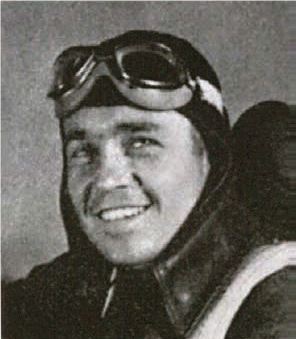
Fig.15
Sam Francis as an aviation cadet in the Morton Air Academy yearbook, autumn 1943
© Sam Francis Foundation, California/ARS, NY and DACS, London 2019
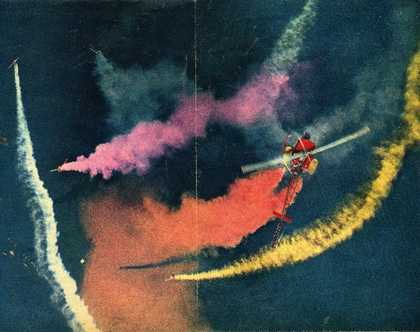
Fig.16
Photograph of Sam Francis’s Sky Painting over Tokyo Bay, 8 June 1966, from a brochure documenting the event
Sam Francis Papers, 2004.M.8, Getty Research Institute, Los Angeles, box 143, folder 7
© Sam Francis Foundation, California/ARS, NY and DACS, London 2019
Photo: Yomiuri Shimbun
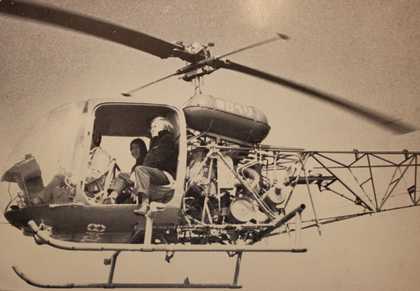
Fig.17
Francis with a news crew in a helicopter over Tokyo Bay before his Sky Painting took place, 1966
© Sam Francis Foundation, California/ARS, NY and DACS, London 2019
Photo: Yomiuri Shimbun
By now it is clear that Francis was a traveller – he loved to fly, but not only as a passenger. In his role as an aviation cadet from 1942 to 1943 for the US Army Air Corps Reserves he logged over seven hundred hours in the cockpit (fig.15). He had aspired to be a reconnaissance pilot, a dream that was broken due to a sustained bout of spinal tuberculosis.36 Flying, in fact, begat painting: it was only as a form of therapy that Francis first took up a brush, in 1945. Although piloting was foreclosed as a profession, Francis continued to fly throughout his life, notably completing a Sky Painting in Tokyo in 1966 (figs.16 and 17) – an air display in which choreographed helicopters flying low over the bay sprayed separate trails of blue, white, magenta and yellow smoke in their wake. Francis, himself one of the pilots, directed the five other Asahi helicopters from the aerobatic team Blue Lark in predetermined patterns for a duration of fifteen minutes.37 With artist James Turrell, Francis reprised the work in April 1969 in Los Angeles, this time using two First World War biplanes.38
It would be supremely difficult for anyone charged with manning an aeroplane to endorse an interpretation of perception that ignored its situated, bodily nature. Scores of studies conducted after the First and Second World Wars exposed links between sometimes-fatal piloting mishaps and episodes of spatial disorientation (then called vertigo). This was defined as a pilot’s failure to accurately sense his or her position, motion or altitude relative to the earth’s surface and the gravitational vertical.39 By the time Francis painted Around the Blues, one seminal study found that ninety-six per cent of jet pilots had experienced spatial disorientation.40 The study went on to detail that its onset was most frequently accompanied by poor visibility – meaning loss of ground or horizon line – and, relatedly, flight at high altitudes, which diminished the clarity of these same cues.41 However counter-intuitive it may have seemed, the use of flight instruments installed in the cockpit rather than vision alone enabled pilots to successfully recover from spatial disorientation.
Pioneering research undertaken in the 1950s by perceptual psychologist James J. Gibson built upon the lessons of wartime aviation. As a military advisor for pilot training from 1942 to 1945, Gibson saw at first hand the woeful inadequacy of received theories of perception, especially in studies designed to test the accuracy of placing a bomb or landing a high speed plane on a limited surface, like that of an aircraft carrier.42 Gibson’s book The Perception of the Visual World (1950) sought to provide an updated perceptual framework for the quandaries of military aviation. He posited an embodied perceiver rather than an information-processing brain, an emphasis on the properties of the surrounding environment rather than on variables of light, and the detection of meaningful data rather than an elaboration of meaningless sensations. While theories of perception had historically been premised on the visual apprehension of information within a static, discrete frame, Gibson devoted much of his book to the problem of perception in movement, and specifically of aircraft motion.43 Significantly in the present context – and bringing us full circle to art critics’ diagnoses of pictorial depth and planar expansion in Francis’s travel paintings – Gibson placed in opposition two types of visually apprehensible surfaces: horizontal (perpendicular to the line of sight, like a stop sign ahead) and longitudinal (parallel with the line of sight, like the ground underneath one’s feet).44 These definitions aided Gibson in explaining how a surface’s texture enabled an observer to discern the distance between the two. As Francis’s ruminations on spatial perception took form in the travel paintings, an adjacent field’s emerging lexicon surpassed the formalist vocabulary of art history. It instead offered, with conceptual clarity and nuance, an embodied version of spatial sensation that accounted for the complex and hard-won perceptual operations honed by the pilot.
Exploring the infinite
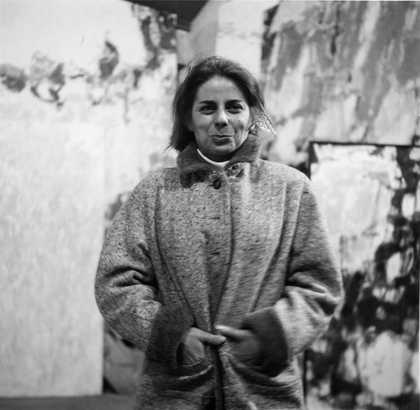
Fig.18
Rachel Jacobs in Sam Francis’s Arcueil studio, c.1956, with (clockwise from upper left) Basel Mural III 1956–8 in progress, Untitled 1956, Untitled 1956 and Amerika (Grey Blue) c.1952
© Sam Francis Foundation, California/ARS, NY and DACS, London 2019
Francis’s camaraderie with philosopher Rachel Jacobs (fig.18) kept him abreast of philosophical discourses around perception in the years before and during his work on the travel paintings.45 If her extant notes are a reliable indication, Jacobs was a voracious reader, scrutinising texts across aesthetics and psychology, with a particular interest in the writings of analytic philosophers Bertrand Russell (1872–1970), Gottlob Frege (1848–1925) and Ludwig Wittgenstein (1889–1951).46 Jacobs was also an attentive observer of Francis’s paintings, and often relied upon them in her writing as a means of bringing her philosophical musings to bear on the material world. In the introduction she penned for the pamphlet for Francis’s 1956 exhibition at the Galerie Rive Droite in Paris, Jacobs wrote of the ‘hypothetical intellect of a two-dimensional creature whose being is limited to traveling across the surface of a sphere. More than the angels, such a creature would taste the delights of the sense of the infinite … its horizon would be both utterly proximate and infinitely receding.’47 In opening her essay in this way, Jacobs decisively placed Francis’s paintings in dialogue with ongoing philosophical debates about the nature of spatial knowledge. She referred to a discussion about the logical limits of the empirical world carried out by physicists Hermann von Helmholtz (1821–1894) and Albert Einstein (1879–1955), as well as Wittgenstein, Russell and others, who contested whether non-Euclidean space was imaginable. Non-Euclidean geometry explores the possibility of (theoretically unlimited) higher spatial dimensions through its opposition to ancient Greek mathematician Euclid’s famous fifth postulate, the ‘parallel postulate’. One significant conclusion drawn from the parallel postulate was that two parallel lines can never meet, yet this does not apply when the two lines are drawn, for instance, on a curved surface. The argument that non-Euclidean space was imaginable, as endorsed by Jacobs, posited a spherical surface that is both finite (because it has a knowable surface area) and unlimited (because it can be traversed or encircled endlessly).48
Although for these thinkers the question of non-Euclidean space was a wholly theoretical one, Jacobs juxtaposed it with the world of commonplace experience, and, in particular, the experience of viewing a painting. ‘Unlike the mathematical angel,’ she wrote, ‘a surface for us is at the end of a distance … [Can] an absolute exploitation of two dimensions call into question the actual perceiving of surfaces?’49 For Jacobs, then, painting maintained the possibility of defying Euclidean space because its surface, while finite, alluded to a potentially unlimited, infinite depicted space. In the same text, Jacobs diagnosed two types of space in the work of abstract painters: the mere abutting of flat shapes on the canvas’s surface on the one hand, and a deep pictorial space on the other. In her view, Francis’s work subverted these two general categories, instead attaining a spatial ambiguity that addressed both ‘distance’ and a ‘sense of extension’.50 While Jacobs did not articulate any neat conclusions about the nature of Francis’s pictorial space, her alignment of his canvases with the rigorous debates of analytical philosophy adds density to the intellectual context in which the paintings were produced. Given Francis and Jacobs’s close rapport in these years, it also solidifies Francis’s own fluency with philosophical debates about the knowability of space.
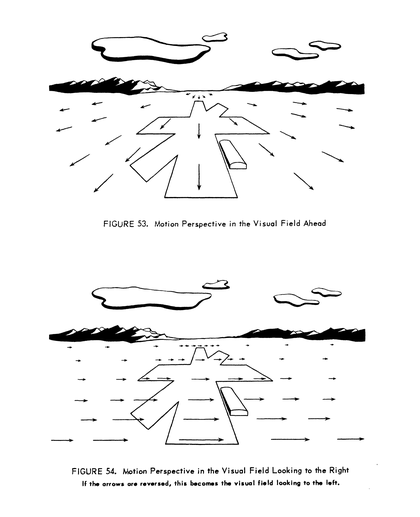
Fig.19
Diagrams illustrating the deformation of the visual field at high velocity, published in James J. Gibson, The Perception of the Visual World (1950), p.121
The prospect of the infinite also proved seductive for Gibson, who addressed it in The Perception of the Visual World when discussing the deformation of surfaces in the visual field at high velocity. He discerned that if these two-dimensional views of a three-dimensional visual field in motion (fig.19) could be combined into a single scene, one would end up with precisely that two-dimensional sphere of non-Euclidean space interrogated by Jacobs as a philosophical and painterly problem. He speculated that if humans had a visual field that spanned the width of the horizon – ‘if they could see all the way around at the same time’ – then ‘the field during locomotion would appear to open up ahead and close in behind in a rather astonishing manner’.51 This, of course, is an impossible scenario for human vision as we know it, and Gibson was left to conclude that humans ‘are, with good reason, perfectly content with the visual world as it is normally perceived, conforming to the rules of Euclidean geometry’.52
What Francis’s paintings indicate, however, is that the artist was dissatisfied with the mundanity of space ‘as it is normally perceived’. His investigation in the travel paintings of the nature and knowability of space constituted a rejoinder to this claim. If the perceptual insights and uncertainties gained in air travel fruitfully shifted Francis’s frame of reference and experience – thereby enabling the production of new work – his added engagement with philosophical discourse around non-Euclidean space demonstrated the depth of the questions with which he was grappling.
In the context of Around the Blues and debates about spatial infinity, two final quotes warrant rehearsal. Early on, Francis revealed ‘I have the feeling that white is like the space that extends between things’.53 Then, later in life, he recalled: ‘It always interested me that there are different kinds of infinity, all kinds.’54 To be sure, white extends across the large centre-right passage in Around the Blues, just as it describes an indeterminate pictorial depth there and in the modulated white expanses at the canvas’s left and right margins. But the extent of this space’s depth or lateral extension, its infinity (or not), will always be uncertain, just as one cannot always trust one’s eyes while in flight.
This uncertainty was at the heart of Francis’s investigation in the travel paintings, hence his reluctance to circumscribe the connotation of infinity: ‘there are different kinds … all kinds’. It is this uncertainty that we are left to consider in front of the travel paintings, and that makes them more than material evidence of Francis’s process of restless aesthetic enquiry. The travel paintings are, to return to Alloway’s formulation, ‘space without place’, and it is in this sense that they are relatable, both to us and to Francis. In a short article published in a Japanese newspaper in 1957 during his first of many trips to Tokyo, Francis argued for the importance of the artist in a world rife with misunderstanding. In a succinct final query, Francis condensed the perceptual, philosophical and experiential enquiries that occupied him in the travel paintings. He wrote, in closing, ‘even though often running away from himself, [the artist] will always come to himself again and again … Where, in fact, is he?’55
